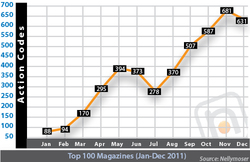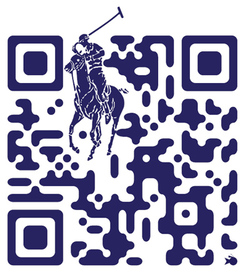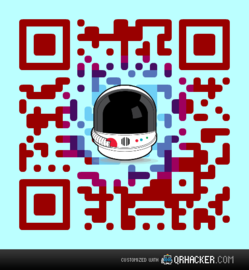Who the heck actually snaps a QR code? Seriously, you’ve gotta be motivated: pull out your phone, find your code-scanning app, fumble for focus, and then wait for the network to take you to… what exactly? You’re never sure. QR codes are opaque. They’re intended to be gobbled down by robots (or barfed up), and so have no meaning to actual humans. QR codes ask for a leap of faith that is typically rewarded with only an advertisement on the other side. I remain deeply skeptical of QR codes as a marketing device, but that doesn’t necessarily mean they won’t find their place in other domains.
Use QR codes as footnotes

Like QR codes, footnotes are opaque, offering only a whiff of information scent. But the kind of information we expect of footnotes is at least generally understood. Footnotes are portals to information that’s tangential to the text, offers technical details, provides a caveat to the main point, or otherwise takes a deep dive into details that are primarily of interest to a narrow sliver of the audience. They are paths to relatively obscure information, not the main event. Like footnotes, QR codes ask you to break out of a narrative to chase down a vague cloud of related information. You have to be deeply interested in what’s on the other side to take that plunge. They’re best for the truly motivated—not a casual audience.
That means QR codes are lousy for marketing slogans and simple ads, where a good old-fashioned URL is more effective, more memorable, and possibly even as machine-readable, as Kevin Marks points out:
With a URL they could type it in, take a photograph of it and type it in later, or if they have the right app, it will recognise the URL text from the image and make it clickable.
That is the irony of this. QR Codes ignore years of research and culture on how to communicate meaning in symbolic form designed to be captured by image processing tools behind a lens. We have this technology. It is called writing.
Written language has a set of symbols that are relatively unambiguous, that are formed of curves rather than hard edges making them resilient to noise, and have been market-tested for milennia. QR Codes don’t just ignore this, they ignore the relative success of one dimensional barcodes. Notice something about a barcode? It has the number printed on it as well, so you can type it in if the scan fails.
Then again, those barcode numbers don’t exactly hold lots of meaning for most of us, either. In fact, that’s when QR codes (and barcodes, too) are at their most useful: replacing impenetrable strings of numbers that are at least as opaque as the QR code itself. That’s especially true for information that you want to present out in the world to those who are motivated to fetch it. Shelley Bernstein of the Brooklyn Museum offered up some good examples of how New York City is using QR codes to fast-track mobile access to personally important information:
I think we are starting to see a tide change in New York City. For starters, the city is using them on all the building permits, so you can learn more as you pass construction sites. There are plans in the works for QR codes on all the restaurant inspections plaques. If there’s one thing that would motivate people to jump the technical hurdles of installing a QR reader, this would be it—the notion that we could see the actual violations that led to a restaurant’s letter grade makes QR truly useful for those of us who obsess about where we eat.
These examples reveal information hidden behind the inscrutable id of a bureaucratic permit or violation, both of which would make for tough-to-type, tough-to-remember URLs. The examples are well suited to a mobile context, too, ideal for someone who wants to know the information now. They’re motivated. These are footnote examples. QR codes are good for linking to obscure information tailored to a specific context and interest.
But will people really use them?
Even if we start using QR codes the right way, will they ever get traction? It’s still early, but we do see that people are starting to use them. According to comScore, 6.2 percent of US mobile users scanned a QR code in June 2011, and that number rose to 8.6 percent by October. That’s a lot of people, an increase from 14 million to 20.1 million in just four months.
It’s hard to know whether that increase is thanks to genuine interest in QR codes or a passing curiosity factor due to the deluge of these things flooding our environment. The top 100 US magazines saw the number of QR codes increase 439 percent over the course of 2011, according to Nellymoser. That study showed that QR codes are overwhelmingly used for ads, swamping the kind of editorial footnotes for which they’re better suited. Even editorial QR codes are moving in an ad direction: “In the beginning of the year, editorial codes were dominated by videos related to features in the magazine. By the end of the year, many of the editorial codes were for sweepstakes run in the editorial section.”

Banal use of QR codes for marketing is unlikely to keep drawing people, though, and it may even poison the well. Adam Greenfield and his crew at Urbanscale did some informal guerilla research in the streets of New York, showing people QR codes, asking them if they knew what they were, and then trying to coach them through scanning one. Awareness of QR codes was fairly high, but less than 10 percent were able to resolve a QR code into a URL, and most weren’t interested anyway:
A strong theme that emerged — which we certainly found entirely unsurprising, but which ought to give genuine pause to the cleverer sort of marketers — is that, even where respondents displayed sufficient awareness and understanding of QR codes to make use of them, virtually no one expressed any interest in actually doing so. As one of our respondents put it, “I’ve already seen the ad, and now I’m going to spend my data plan on watching your commercial? No thanks.”
If traditional ads aren’t motivating enough, what about more editorial content? It seems even there, with footnote-style information, people are slow to warm up to QR codes. At the Brooklyn Museum, Shelley and her team have been typically innovative in ways to use QR codes to supplement exhibitions, with mixed results. The museum was reasonably pleased by visitors’ use of QR codes that supplement wall text (“I want to know more about this”), but was disappointed in other areas. In one case, replacing a text-based scavenger hunt for mobile phones with the same game driven by QR codes resulted in a five-fold drop in participation. The codes actually chased the audience away. For advertising, it was a bust, too:
We put a QR code on all the advertising for [the exhibition] The Latino List, so people could download the exhibition’s iPhone app. Given the amount of advertising that was done, it seems incredible that the code was scanned only 118 times. Yes, that’s right, 118 scans, but this figure seems right in line with Adam Greenfield’s research at Urbanscale.
So, I think what we end up with is simply a project that isn’t an overwhelming success or failure. Certainly, QR on advertising didn’t do so well for us. QR use in the building is overall very low, with visitors seeming to favor application-like uses for it. However, compared to pre-QR code use, the use of those applications dropped significantly. This suggests that QR might be appropriate for special projects, but that we probably need to stay away from it as a baseline visitor amenity if we are to be at all inclusive about how we serve content.
Label the portal
Still, the relative success of the wall-text QR codes in Brooklyn suggests that QR codes are at their best when the benefits are evident and it’s clear what’s on the other side. That means there’s some important design work to do around QR codes: Let me know what I’m going to get from this hassle. Nellymoser says advertisers are starting to do this by offering explanatory captions next to QR codes in their magazine ads:
By Q4, more than two-thirds of all action codes (1327 or 70%) were accompanied by information that described what happens after the scan. This is considered by many to be a best practice and follows the pattern of many other calls to action.
Labeling QR codes is a good start, and it may likewise help to improve the design of the QR codes themselves. Turns out QR codes don’t have to be a black-and-white jumble; they can include color and even images. For example, Ralph Lauren’s agency, Red Fish Media, whipped up a custom QR code that featured the company’s iconic polo player, reporting that the designed codes see three times the action as the plain vanilla version.

It’s not hard to create a custom QR code, either, thanks to tools like QRhacker, which lets you generate a QR code and then customize it with colors and images, even changing the shape of the dots in the code. Using QRhacker I whipped up this QR code for the futurefriend.ly site in all of two minutes:

Captions, images, and color help give unwelcoming QR codes some identity and, more important, an information scent that hints at what’s on the other side. At a time when touch interfaces—and even the humble text link—are cutting through complexity by using content itself as navigation, an opaque, unadorned QR code feels like a step backward. Making the codes visually meaningful is helpful.
In the end, though, the thing that will most coax people to overcome the technical barriers of QR codes is simply linking them to actually meaningful content. Traditional advertising messages won’t cut it. Go figure, but pulling someone through a QR portal means we have to give people information they actually want or need.





